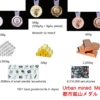12th Members’ Meeting: Circular Economy Gathering with Professor Hosoda
“The dawn of circular economy”
by Eiji Hosoda
Professor
Chubu University
I have been constantly pondering how different is the Circular Economy proposed in Europe compared with the traditional recycling-oriented society which has long been existing in Japan. The difference between the two is not clear even after reading relevant documents. It is certain, however, that the former put emphasis on promoting economic growth or increasing in employment, while the latter does not really touch upon those topics. Further, the latter stresses the regional circulation, while the former does not put too much emphasis on the matter. There are some differences between the two from the above point of view. A basic concept, however, is common that the input of natural resources is reduced and in return the discharge of residual waste is minimized in the natural environment by intensifying resource recycling.
After much contemplation, I ultimately came to the following simple conclusion: Circular economy does not simply mean an economy that achieves reducing waste, reusing and recycling resources but, beyond that, realizing new economy backed by creation of added value. Construction of the circular economy is, thus, to create a new economy differing from the old economy. Some might think that the above concept is the same as the European-type Circular Economy aimed at promoting economic growth and boosting employment.
No, it is not. In the first place, the idea that an economy grows endlessly has been outdated, a concept of an old era. The GDP is marketed value of goods and services produced, and the increase of GDP used to be considered as economic growth. The GDP growth on its own can now hardly be regarded as an indicator of true happiness of human beings, particularly in developed countries that are already wealthy. In contrast, “new added-value” is marketed value-added combined with non-marketed value-added, and thus, different from the conventional concept of value-added which is rather inclined to marketed value-added.
To tell the truth, the real economy is already turning the rudder in the direction of pursuing the new value-added. Lifestyles of people have drastically changed. People are no more gaining happiness from living an abundant life as they did in the past. It is obvious from the survey by the Cabinet Office. More than 60 per cent of Japanese are seeking after spiritual happiness rather than material wealth. There is a clear tendency among young people being disillusioned with material possession. Upon being asked what they want, a typical answer of the majority of students in my class would be “Nothing in particular”.
People nowadays feel happy in living a spiritually fulfilled life. Moreover, people feel happy to bond with others. Neither Ludwig Feuerbach nor Karl Marx has to be relied upon to find that human beings are ”species-being (Gttungswesenor)”. Precisely because of this nature of human beings, people feel happy to live together. People do not feel happy simply because of material abundance. Important as material is, of course, the question is how much happiness can we derive from it. On one occasion, more happiness can be generated by sharing, and on another occasion by cooperating together. Neither of these values is seldom recognized as marketed value-added.
Unfortunately, however, the production style has not caught up with the value yet. As usual, materials and traditional services are erroneously believed to bring happiness to people. Paradoxical as it may sound, these delays in changes of production style can be said to cause to slow the economic growth. New business opportunities should be generated through efforts to newly create non-marketed value-added along with marketed value-added as well as increase people’s happiness. It is clear just by glancing at LINEs, Skype or Facebook.
A circular economy is an economic system that enables us to achieve the mission to maximize people’s happiness through providing us with the value regardless of whether it is marketed or non-marketed. It is, therefore, sufficient if material as a resource plays a role something like a platform to carry function and service. Material circulates within the economy endlessly. The happiness of people increases, as the value – marketed or non-marketed – can be loaded on materials and distributed to make people happier no matter whether an economy grows or not.
It goes without saying that the key to success lies on business. For this reason, the business style needs be changed. As a famous proverb of successful Omi merchants in Japanese history goes, “triple win is the best way of commerce – good for sellers, good for buyers, and good for whole society.” The modern version of this lesson is circular economy.
Meeting Agenda
Date & Time: 13:30 ~ 16:30, November 15, 2019
Venue: 3rd floor, Yaesu Rotary Bldg., 1-7-17, Yaesu, Chuo-Ku, Tokyo 103-0028. (3 minutes of walk from Yaesu Central Gate of JR Tokyo station)


ディスカッション
コメント一覧
まだ、コメントがありません